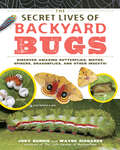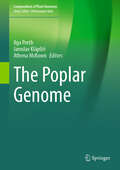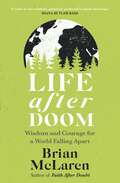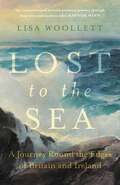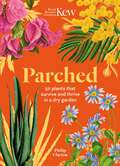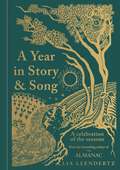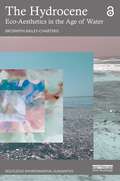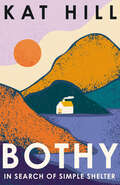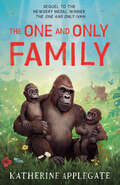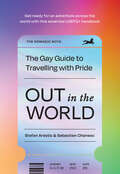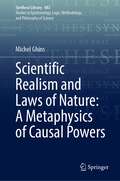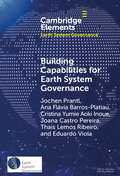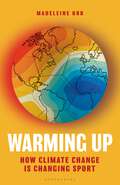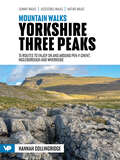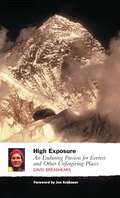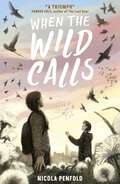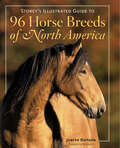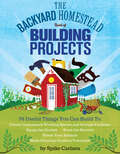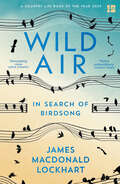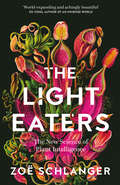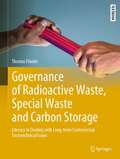- Table View
- List View
Sew & Stow: 31 Fun Sewing Projects to Carry, Hold, and Organize Your Stuff, Your Home, and Yourself!
by Betty OppenheimerIndulge your passion for sewing as you clear your life of clutter. Whatever your experience and wherever the mess, you can sew up a cloth sack or organizer to fit your needs. Gardening tools, groceries, shoes, toys, jewelry, and more will find new homes in these colorful and reusable handmade alternatives to mass-produced products. With Betty Oppenheimer&’s easy-to-follow instructions for 31 fun and functional projects, you&’ll be inspired to break out your needles and create a more organized, bright, and eco-friendly home.
The Secret Lives of Backyard Bugs: Discover Amazing Butterflies, Moths, Spiders, Dragonflies, and Other Insects!
by Judy Burris Wayne RichardsThis fun book will have kids bugging out! Explore the fascinating miniature world of spiders, beetles, grasshoppers, butterflies, and more as stunning photography combines with expert information to create an up-close-and-personal look at the hidden lives of these tiny backyard residents. Watch each creature progress through different life stages as they eat, grow, and learn in a natural setting. Surprising and captivating, this one-of-a-kind introduction to the crawlers and flyers just outside the door is a delight for nature lovers of all ages.
Sew What! Bags: 18 Pattern-Free Projects You Can Customize to Fit Your Needs
by Lexie BarnesFrom daypacks for hiking to everyday grocery totes, bags are an essential accessory for life on the go. In this inspiring guide, Lexie Barnes shows you how to create handmade bags that provide customized functionality while showcasing your own personal style. With step-by-step instructions for 18 pattern-free projects that include drawstring sacks, handbags, and messenger bags, Barnes encourages you to experiment with bold fabrics, hand-picked materials, and purpose-tailored dimensions to create fashionably unique bags that are suitable for your individual needs.
The Poplar Genome (Compendium of Plant Genomes)
by Ilga Porth Jaroslav Klápště Athena McKownThis book is the first comprehensive compilation of research on state‐of‐the-art genomics on the most advanced model tree species including genome assemblies, insights into genomic structural features and methylation patterns, whole‐genome resources used for population genomics and adaptation to climate, enabled breeding vs. classical genetics and traditional breeding, comparative genomics, and elucidations on functional genomics. The latest developments in the genomics of wood formation are particularly highlighted. Altogether, the book contains over 300 pages in over 15 chapters authored by globally reputed experts in the relevant fields of this tree crop’s genomics research. This book is useful for students, teachers, and scientists in academia and governmental or private tree improvement agencies or companies interested in genetics, pathology, entomology, physiology, molecular genetics and breeding, in vitro culture and genetic engineering, land restoration, and agroforestry solutions.
Life After Doom: Wisdom and Courage for a World Falling Apart
by Brian D. MclarenWhat does faith look like when cynicism seems more plausible?What does hope look like when hope seems irrational?What does love look like when hate becomes more popular?In recent years, author and activist Brian McLaren has sensed a widespread emotional shift among growing numbers of people. More and more friends, colleagues, students, and readers confess their sense of futility, their feelings of frustration bordering on despair. They feel that human civilization has passed certain tipping points and that a tide of doom is inexorably rising. This feeling creates a deep inner divide, a tension between a sincere and hopeful commitment to action for the common good on the one hand, and on the other, a feeling that no actions can prevent the arrival of an undesirable or even dystopian future.Life After Doom is a sober analysis of how things stand in relation to climate breakdown, and a deeply insightful exploration of the challenge of living well, maintaining resilience and growing in wisdom and love in the face of nations, ecosystems, economies, religions, and other institutions in disarray. Brian McLaren is the author of Faith After Doubt and Do I Stay Christian? and is a leading and authoritative voice at the intersection of religious faith and contemporary culture.'A book of rare wisdom, genuinely profound in depth and scope'DIANA BUTLER BASS
Lost to the Sea: A Journey Round the Edges of Britain and Ireland
by Lisa Woollett'An immersive and lyrically personal journey through deep-time and modern tides' RAYNOR WINN'Wondrous, elegant and haunting, Lost to the Sea is a fascinating alternative history of the fractured, flooded and eroded edges of Britain and Ireland' PHILIP HOAREMedieval kingdoms. Notorious pirate towns. Drowned churches. Crocodile-infested swamps.On a series of coastal walks, Lisa Woollett takes us on an illuminating journey, bringing to life the places where mythology and reality meet at the very edges of Britain and Ireland.From Bronze Age settlements on the Isles of Scilly and submerged prehistoric forests in Wales, to a Victorian amusement park on the Isle of Wight and castles in the air off County Clare, Lisa draws together archaeology, meetings with locals and tales from folklore to reveal how the sea has forged, shaped and often overwhelmed these landscapes and communities.Lost to the Sea is an exhilarating voyage around the ever-shifting shores of the British Isles, and a haunting ode to our profound relationship with the sea.'A hugely enjoyable mosaic of history, myth and imagination' SARA WHEELER'Beautifully written and researched . . . I was immediately tempted to head out in search of lost lands' WYL MENMUIR
Kew - Parched: 50 plants that thrive and survive in a dry garden
by Philip ClaytonDazzling, diverse, durable - discover the remarkable drought-proof plants that flourish in the driest environments.With rainfall unpredictable and summers increasingly hot, plants that survive and thrive in these conditions have become more important than ever. Through expert text and beautiful botanical illustrations from the archives of the Royal Botanic Gardens, Kew, Parched explores the captivating variety that exists in the world of dry plants. From poppies and palms to cypress and cyclamen, this stunning book showcases the incredible species that have become a mainstay of dry gardens around the world.
A Year in Story and Song: A Celebration of the Seasons
by Lia LeendertzA Year in Story and Song is a captivating collection of stories and songs that celebrates the seasons. We humans love stories. We love to hear them and to tell them, around fires and by bedsides, and we love to use them to make sense of the world around us. The seasons, in all their ever-changing variety, give us many opportunities for storytelling: the full moons and their names, Epiphany in January, St Patrick's Day in March, May Day, Midsummer, Halloween and more. They feature mischievous boggarts and fairies, saints and sailors, leprechauns and dragons, pilgrimages and charms, milk maids and rose queens, Robin Hood and the green man. The songs range from shanties and love songs, to bawdy ballads and wassails, to carols and rounds, and have been sung for hundreds of years, often at particular moments in the calendar.This is a book to treasure all year, every year.
The Hydrocene: Eco-Aesthetics in the Age of Water (ISSN)
by Bronwyn Bailey-CharterisThis book challenges conventional notions of the Anthropocene and champions the Hydrocene: the Age of Water. It presents the Hydrocene as a disruptive, conceptual epoch and curatorial theory, emphasising water's pivotal role in the climate crisis and contemporary art.The Hydrocene is a wet ontological shift in eco-aesthetics which redefines our approach to water, transcending anthropocentric, neo-colonial and environmentally destructive ways of relating to water. As the most fundamental of elements, water has become increasingly politicised, threatened and challenged by the climate crisis. In response, The Hydrocene articulates and embodies the distinctive ways contemporary artists relate and engage with water, offering valuable lessons towards climate action. Through five compelling case studies across swamp, river, ocean, fog and ice, this book binds feminist environmental humanities theories with the practices of eco-visionary artists. Focusing on Nordic and Oceanic water-based artworks, it demonstrates how art can disrupt established human–water dynamics. By engaging hydrofeminist, care-based and planetary thinking, The Hydrocene learns from the knowledge and agency of water itself within the tide of art going into the blue.The Hydrocene urgently highlights the transformative power of eco-visionary artists in reshaping human–water relations. At the confluence of contemporary art, curatorial theory, climate concerns and environmental humanities, this book is essential reading for researchers, curators, artists, students and those seeking to reconsider their connection with water and advocate for climate justice amid the ongoing natural-cultural water crisis.The Open Access version of this book, available at http://www.taylorfrancis.com, has been made available under a Creative Commons Attribution-Non Commercial-No Derivatives (CC-BY-NC-ND) 4.0 license.
The Hydrocene: Eco-Aesthetics in the Age of Water (ISSN)
by Bronwyn Bailey-CharterisThis book challenges conventional notions of the Anthropocene and champions the Hydrocene: the Age of Water. It presents the Hydrocene as a disruptive, conceptual epoch and curatorial theory, emphasising water's pivotal role in the climate crisis and contemporary art.The Hydrocene is a wet ontological shift in eco-aesthetics which redefines our approach to water, transcending anthropocentric, neo-colonial and environmentally destructive ways of relating to water. As the most fundamental of elements, water has become increasingly politicised, threatened and challenged by the climate crisis. In response, The Hydrocene articulates and embodies the distinctive ways contemporary artists relate and engage with water, offering valuable lessons towards climate action. Through five compelling case studies across swamp, river, ocean, fog and ice, this book binds feminist environmental humanities theories with the practices of eco-visionary artists. Focusing on Nordic and Oceanic water-based artworks, it demonstrates how art can disrupt established human–water dynamics. By engaging hydrofeminist, care-based and planetary thinking, The Hydrocene learns from the knowledge and agency of water itself within the tide of art going into the blue.The Hydrocene urgently highlights the transformative power of eco-visionary artists in reshaping human–water relations. At the confluence of contemporary art, curatorial theory, climate concerns and environmental humanities, this book is essential reading for researchers, curators, artists, students and those seeking to reconsider their connection with water and advocate for climate justice amid the ongoing natural-cultural water crisis.The Open Access version of this book, available at http://www.taylorfrancis.com, has been made available under a Creative Commons Attribution-Non Commercial-No Derivatives (CC-BY-NC-ND) 4.0 license.
Bothy: In Search of Simple Shelter
by null Kat Hill‘The bothy embrace is addictive’ ADAM NICOLSON 'Will have you reaching for your boots’ CAL FLYN The door to the bothy is always unlocked, you just need to step inside. You will find them in the mountains. You will find them in the wilderness. A bothy is a remote hut you can’t reserve, with no electricity, mod-cons or running water. And it’s here you’ll find Kat Hill – kettle on, feet up and pen out. Leading us on a gorgeous and erudite journey around the UK, Kat reveals the history of these wild mountain shelters and the people who visit them. With a historian’s insight and a rambler’s imagination, she lends fresh consideration to the concepts of nature, wilderness and escape. All the while, Kat weaves together her story of heartbreak and new purpose with those of her fellow wanderers, past and present. Writing with warmth, wit and infectious wanderlust, Kat moves from a hut in an active military training area in the far-north of Scotland to a fairy-tale cottage in Wales. Along her travels, she explores the conflict between our desire to preserve isolated beauty and the urge to share it with others – embodied by the humble bothy. Bothy is a stirring, beautiful book for anyone who longs to run away to the wilds.
The One and Only Family (The One and Only Ivan)
by null Katherine ApplegateFrom beloved author Katherine Applegate comes The One and Only Family, the final instalment in the series that began with the Newbery Medal-winning, #1 New York Times bestselling modern classic The One and Only Ivan and its sequels, The One and Only Bob and The One and Only Ruby. Ivan has been happily living in a wildlife sanctuary, with his friend Ruby next door in the elephant enclosure, frequent visits from his canine friend Bob, and his mate Kinyani by his side. And in the happiest turn of all, Ivan and Kinyani have welcomed a set of twins to their family! Ivan loves being a papa, even though it can be hard sometimes. But as he navigates the joys and challenges of parenthood, he can’t help but recall his life before the glass walls of the mall circus, his own childhood in the jungle – and his own twin. In the tradition of timeless classics like Charlotte’s Web and Stuart Little, the one and only Katherine Applegate has crafted a poignant, delightful, heartbreaking, unforgettable final foray into the world of Ivan, the world’s favorite silverback.
Out in the World: The Gay Guide to Travelling with Pride
by null Stefan Arestis null Sebastien ChaneacOut in the World is THE indispensable guide to LGBTQ+ travel from The Nomadic Boys – full of tips, advice and resources on the best and safest places to visit around the world. Get ready for a fabulous adventure across the world with this essential guide to LGBTQ+ travel. The Nomadic Boys share their favourite travel experiences spanning six continents in gorgeous technicolour, giving you tips, advice and resources for making the most of every destination. Plan your own trip of a lifetime, exploring the world's most dazzling Pride celebrations whilst discovering top-notch spots for great food and drink. From must-see landmarks to hidden gems – whether you dream of snorkelling in the Philippines, skiing in Canada, stargazing in New Zealand or partying in the streets of Mexico – this is your ticket to travel with pride! - Travel with confidence - Connect with local LGBTQ+ communities - Find practical tips for travelling safely - Make the most of every destination
Scientific Realism and Laws of Nature: A Metaphysics of Causal Powers (Synthese Library #483)
by Michel GhinsThis book addresses central issues in the philosophy and metaphysics of science, namely the nature of scientific theories, their partial truth, and the necessity of scientific laws within a moderate realist and empiricist perspective. Accordingly, good arguments in favour of the existence of unobservable entities postulated by our best theories, such as electrons, must be inductively grounded on perceptual experience and not their explanatory power as most defenders of scientific realism claim. Similarly, belief in the reality of dispositions such as causal powers which ground the natural necessity of scientific laws must be based on experience. Hence, this book offers a synthetic presentation of an original metaphysics of science, namely a metaphysics of properties, both categorical and dispositional, while at the same time opposing strong versions of necessitarism according to which laws are true in all possible worlds.The main theses and arguments are clearly presentedin a non-technical way. Thus, on top of being of interest to the specialists of the topics discussed, it is also useful as a textbook in courses for third year and more advanced university students.
Building Capabilities for Earth System Governance (Elements in Earth System Governance)
by null Jochen Prantl null Ana Flávia Barros-Platiau null Cristina Yumie Inoue null Joana Castro Pereira null Thais Lemos Ribeiro null Eduardo ViolaThis Element develops a new Strategic Capabilities Framework for studying and steering complex socio-ecological systems. It is driven by the central question of what are the most essential capabilities that ought to be fostered for addressing the fundamental 21st Century environmental challenges and Earth system transformations. The author's objective is to innovate transformative ideas toward better climate and ocean governance that are of interest both to academics and policymakers in the field. Rather than investigating the design and effectiveness of institutions in governing the climate and the oceans, the authors offer an alternative approach starting from the assumption that global governance arrangements must be informed by the capabilities of the communities affected. This Element aims to offer out-of-the-box thinking about capabilities-focused and community-centered frameworks that align multi-level systems of governance with the fundamental challenges of global environmental change. This title is also available as Open Access on Cambridge Core.
Warming Up: How Climate Change is Changing Sport
by Madeleine OrrThe world of sport has a new opponent: climate change.In recent years, a world championship marathon was held at midnight to avoid the blistering sun. Professional athletes needed oxygen tanks to play during wildfire season in California. Players collapsed and play was suspended amid the heat and bushfire smoke at the Australian Tennis open. Ski resorts in the Alps have turned into ghost towns. Golf courses are sinking into the sea. And then there's the Qatar World Cup, among the greatest follies in sporting history, one that saw hundreds (perhaps thousands) of heat-induced deaths before a ball was even kicked. The threat climate change poses to sport is clear, but with billions of participants and fans around the world who rely on the sector for entertainment, jobs, fitness and health, this is one industry we can't afford to lose. In this book, Madeleine Orr shows it doesn't have to be this way. There are ways to mitigate, and perhaps counter, even the worst elements of climate change. A world-leading sport ecologist, Madeleine interviews athletes, coaches, politicians and thought-leaders to learn more about the inevitable consequences for this trillion-dollar industry. From the frontlines of climate change, Warming Up takes readers through a play-by-play of how global warming is already impacting sport, and how the sports world can fight back.
Warming Up: How Climate Change is Changing Sport
by Madeleine OrrThe world of sport has a new opponent: climate change.In recent years, a world championship marathon was held at midnight to avoid the blistering sun. Professional athletes needed oxygen tanks to play during wildfire season in California. Players collapsed and play was suspended amid the heat and bushfire smoke at the Australian Tennis open. Ski resorts in the Alps have turned into ghost towns. Golf courses are sinking into the sea. And then there's the Qatar World Cup, among the greatest follies in sporting history, one that saw hundreds (perhaps thousands) of heat-induced deaths before a ball was even kicked. The threat climate change poses to sport is clear, but with billions of participants and fans around the world who rely on the sector for entertainment, jobs, fitness and health, this is one industry we can't afford to lose. In this book, Madeleine Orr shows it doesn't have to be this way. There are ways to mitigate, and perhaps counter, even the worst elements of climate change. A world-leading sport ecologist, Madeleine interviews athletes, coaches, politicians and thought-leaders to learn more about the inevitable consequences for this trillion-dollar industry. From the frontlines of climate change, Warming Up takes readers through a play-by-play of how global warming is already impacting sport, and how the sports world can fight back.
Mountain Walks Yorkshire Three Peaks: Walking routes to enjoy on and around Pen-y-ghent, Ingleborough and Whernside (Mountain Walks)
by Hannah CollingridgeMountain Walks Yorkshire Three Peaks by Hannah Collingridge is a guide to walking routes on and around Pen-y-ghent, Ingleborough and Whernside in the Yorkshire Dales National Park. Alongside the routes to the peaks themselves, there are also valley walks for mixed-weather days and those new to hillwalking. The routes explore the local area, visiting local caves and beauty spots and showcasing the stunning limestone scenery; even those who are familiar with the area will find new and imaginative route ideas to discover. Whether you aspire to walk in the southern Dales on a straightforward route, or you're looking to take on the full Three Peaks challenge, this is the only guidebook you need. Together with stunning photography, each route features Ordnance Survey 1:25,000 maps; easy-to-follow, detailed directions; downloadable GPX files; essential information about public transport and safety advice; details about the terrain and navigation; and information about facilities, refreshments and points of interest.
High Exposure: An Enduring Passion for Everest and Other Unforgiving Places
by David BreashearsFor generations of adventurers, from Mallory to Hilary, Norgay to Krakauer, Mount Everest and the world's greatest peaks have provided the ultimate testing ground. But as the public's fascination with mountaineering reaches an all time high, the question remains - why climb? In High Exposure, legendary rock climber, mountaineer and film-maker David Breashears answers with a captivating and intimate look at his life, during which he has scaled many of the world's highest peaks, including two successful ascents of Everest.
When the Wild Calls (Where the World Turns Wild #2)
by Nicola PenfoldHaving escaped their city, Juniper Greene and her brother Bear have settled in Ennerdale with their dad and his family. Every day the wild introduces them to a new wonder, but Juniper can't stop worrying about her grandmother and best friend left behind. When she hears news that disease has entered the city, she's determined to bring her loved ones to safety. Trapped in a city riddled with disease and run by a ruthless leader, Etienne longs for the wild. With the guards becoming more aggressive to counteract the growing rebellion, Etienne's prepared to fight for his freedom. But will he be able to protect himself and keep those around him safe until Juniper returns from the wild?
Storey's Illustrated Guide to 96 Horse Breeds of North America
by Judith DutsonFrom the Pryor Mountain Mustang to the Tennessee Walking Horse, North America is home to an amazing variety of horses. In this lavish, photograph-filled guide, Judith Dutson provides 96 in-depth profiles that include each breed&’s history, special uses, conformation standards, and more. You&’ll learn about homegrown favorites like the Morgan, Appaloosa, and Quarter Horse, as well as exotic imports like the Mangalarga Marchador and the Selle Français. Take a continental horse tour without ever leaving your home.
The Backyard Homestead Book of Building Projects: 76 Useful Things You Can Build to Create Customized Working Spaces and Storage Facilities, Equip the Garden, Store the Harvest, House Your Animals, and Make Practical Outdoor Furniture (Backyard Homestead)
by Spike CarlsenGardeners, small farmers, and outdoor living enthusiasts will love this compilation of 76 rustic DIY projects. From plant supports and clotheslines to a chicken coop, a greenhouse, and a root cellar with storage bins, most of the projects are suitable for complete novices, and all use just basic tools and easy-to-find materials. You&’ll find techniques to build whatever your outdoor world is missing, with additional tips to live sustainably, happily, and independently. Also available in this series: The Backyard Homestead, The Backyard Homestead Seasonal Planner, The Backyard Homestead Guide to Raising Farm Animals, and The Backyard Homestead Book of Kitchen Know-How.
Wild Air: In Search of Birdsong
by null James Macdonald LockhartLonglisted for the 2023 Highland Book Prize ‘Joyful and mindful, a powerful argument for being still and listening’ Sunday Times A book about birds, birdsong and the countryside they inhabit, from the critically acclaimed author of Raptor. In Wild Air, James Macdonald Lockhart sets out to write about a series of birds as though he has his granny’s role of listening to birds’ songs and calls and relaying what she heard to her aged and by then quite deaf father – the famous naturalist Seton Gordon. From a nightjar’s strange churring song on a heath in the south of England, to a lapwing displaying over the machair in the Outer Hebrides, he writes about eight different birds who he has spent most time with, returned to most often and relays what he hears.The eight species are all representative of a different habitat. Nightjars on a lowland heath; shearwaters on a mountain overlooking the sea; dippers on a river; skylarks in farmland; ravens in woodland; divers on a loch; lapwings on the coast; and nightingales in dense scrub. Not all of the birds are songbirds in the traditional sense, though each possesses its own distinctive music. That music can vary from the strange, as in the weird gurgling sound a shearwater makes inside its burrow, to the joyous exuberance of the skylark’s song. Sometimes, he hears a lot, and sees little (shearwaters in the pitch dark); sometimes he sees a lot, but hears little (black-throated divers on their loch). But in every case the sounds the birds make become an introduction to their lives – an audible introduction to the birds and the places they are found.
The Light Eaters
by null Zoë SchlangerA narrative investigation into the new science of plant intelligence and sentience, from National Association of Science Writers Award winner and Livingston Award finalist Zoe Schlanger'. Look at the green organism across the room or through the window: the potted plant, or the grass, or a tree. Think how a life spent constantly growing yet rooted in a single spot comes with tremendous challenges. To meet them, plants have come up with some of the most creative methods for surviving of any living thing, us included. Many are so ingenious that they seem nearly impossible.There is no doubt that plants are important: plants, or their green precursors the blue-green algae and algae themselves, have produced all the oxygen in the Earth’s atmosphere, allowing animals to evolve.But did you know they can communicate when they are being eaten, allowing nearby plants to bolster their defences. They move and that movement stops when they are anaesthetised, just like animals. They also use electricity for internal communication, just like animals. They can hear the sounds of caterpillars eating, just like animals. Plants can remember the last time they have been visited by a bee and how many times they have been visited, so have a concept of time and can count, just like animals. Plants can not only communicate with each other, they can also communicate with other species of plant and animals, allowing them to manipulate animals to defend or fertilise them. This is unlike most other animals.So look again at the potted plant, or the grass or the tree and wonder: Are plants intelligent? Perhaps even more fundamental is are they conscious?Is the only real difference between animals and plants that plants are light eaters, animals aren’t.The Light Eaters will completely redefine how you think of plants. Packed with the most amazing stories of the life of plants it will open your eyes to the extraordinary green life forms we share the planet with. Of course, like animals, plants can also detect light.
Governance of Radioactive Waste, Special Waste and Carbon Storage: Literacy in Dealing with Long-term Controversial Sociotechnical Issues (Springer Textbooks in Earth Sciences, Geography and Environment)
by Thomas FlüelerThis book demonstrates that the long-term safety of nuclear waste repositories, special waste disposal and carbon storage (CCS) is highly challenging and monitoring may contribute to substantiate evidence, support decision making and legitimise the programme. Deep geological disposal is a long-term safety issue and, in parallel, requires long-term institutional involvement of the technoscientific community, waste producers, public administrators, NGOs and the public. What, where and when to monitor is determined by its goal setting: It may be operational, confirmatory (in the near field) or environmental (far field). Strategic monitoring as proposed here contributes to process, implementation or policy and institutional surveillance. It not only addresses the controversial long-lasting “problem” (of nuclear, other toxic or CO2 waste) but investigates some ways to approach for “solutions” or solution spaces – not just technical but also institutional, societal and personal. It includes the tailored transfer of knowledge, concept and system understanding, experience and documentation to specific audiences above. It is an integrative tool of targeted yet adaptive management and may be applicable to other long-term sociotechnical fields.

